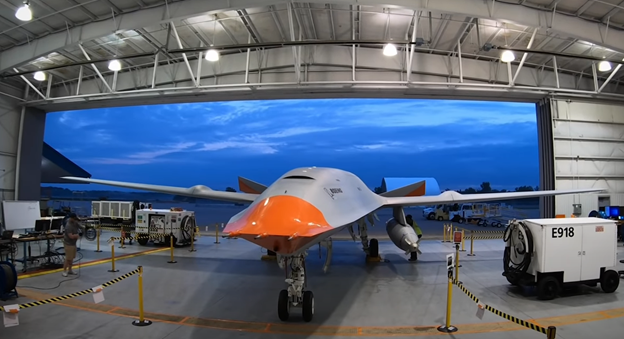
Boeing’s MQ-25 Stingray made aviation history in June 2021 when it refueled a U.S. Navy F/A 18 Super Hornet, becoming the first ever unmanned aircraft to refuel another aircraft. The MQ-25 looks to extend the combat range of the F/A 18 Super Hornet, EA-18G Growler, and the F-35C fighters. The Stingray will also relieve the Super Hornets from their airborne tanker roles, passed on to them to fill the void left by the Navy’s retirement of the KA-6D and S-3B Viking tankers. Further development of the MQ-25 will allow the Super Hornets to focus on their primary missions moving forward.
The most recent test demonstrated advanced manned-unmanned teaming (MUM-T) capabilities in a virtual environment using the MQ-25 Stingray, E-2D Hawkeye, and an F/A 18 Super Hornet. Read Boeing’s full press release below:
A Boeing-led [NYSE: BA] team has demonstrated manned-unmanned teaming (MUM-T) capabilities in a virtual environment using the Navy’s MQ-25TM StingrayTM unmanned aerial refueler, the E-2D Advanced Hawkeye airborne command-and-control aircraft and the F/A-18 Super Hornet.
MQ-25’s First Flight
The demonstration, sponsored by the Office of Naval Research, used Northrop Grumman’s portable E-2D simulator in conjunction with Boeing’s F/A-18 and MQ-25 simulations to establish a data link network that was used to supervise MQ-25 flight operations.
The simulated mission scenarios included the E-2D successfully acting as the air wing “tanker king” while the MQ-25 refueled the F/A-18, in addition to supervising the MQ-25 during an intelligence, surveillance and reconnaissance mission. The E-2D was able to conduct MUM-T operations with the MQ-25 using only existing operational flight program software.
“Two of our key findings from this early demonstration with existing data links are that initial MUM-T capability between MQ-25, E-2D and F/A-18 is achievable with minimal change to the crew vehicle interface and could be integrated into earlier MQ-25 operational deployments,” said Don “BD” Gaddis, MQ-25 Advanced Design at Boeing.
MQ-25 Making Manned/Unmanned Refueling History with U.S. Navy F/A-18
The team also demonstrated how anticipated carrier air wing concepts – such as the F/A-18 and E-2D changing the tanker’s orbit station, flight path or aerial refueling store payload – were made routine and repeatable with the unmanned MQ-25. This required minimal changes to the F/A-18 cockpit display, helping to reduce pilot workload while supervising unmanned operations and providing consistency with how pilots operate and train today.
Another more advanced MUM-T mission simulation showed how an open behavioral software framework can be used to aggregate traditional unmanned system commands into an overall autonomous mission behavior.
MQ-25’s Refuels E-2D Hawkeye Command-and-Control Aircraft
“As a result, pilots can call a ‘play’ for the unmanned system, much like a coach,” Gaddis said. “This ‘play call’ ability greatly simplifies the supervising pilot’s workload and minimizes the data link exchanges required. It’s all part of building platform-agnostic, portable and reusable MUM-T software.”
MUM-T is a key future capability outlined in the Navy’s Unmanned Campaign Plan. The framework is the Navy’s strategy for integrating unmanned systems to provide lethal, survivable and scalable effects in support of carrier strike group operations.
“This demonstration of the E-2D Advanced Hawkeye controlling the MQ-25 builds on our experience in integrating unmanned systems into carrier flight operations. As the airborne command and control node, E-2D will be a critical component to enabling the U.S. Navy’s Unmanned Campaign Framework,” said Janice Zilch, vice president, Manned Airborne Surveillance Programs at Northrop Grumman. “We work closely with industry partners and the Navy in support of meaningful technology demonstrations that showcase E-2D’s agile environment, interoperability and unmatched command and control capabilities.”
Future Boeing MUM-T demonstrations will involve additional mission areas, interface enhancements, autonomous behaviors and resilient, protected networks.
Steve Schneider
Latest posts by Steve Schneider (see all)
- New Chinese Electromagnetic Surveillance Leaves “Nowhere to Hide” on Battlefield - March 15, 2024
- Amazon’s Nuclear Powered Data Center - March 7, 2024
- Skunk Works Rolls Out An Engineering Marvel - March 6, 2024
- Future of Airpower Takes First Flight - March 4, 2024
- A War Beneath the Waves – Trillions of Dollars at Stake - February 9, 2024















